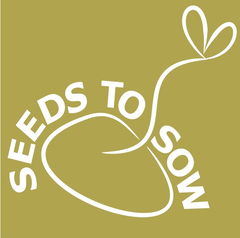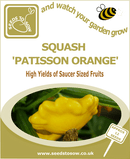Description
Patisson Orange Squash is a high yielding variety with exceptional eating qualities. It produces numerous, saucer sized orange patty-pan fruits. Best eaten fresh from harvesting.
| When to Sow | March to Mid May indoors, May to June outdoors. |
| Where to Sow | All squash need well-drained, nutrient-rich soil. |
| If sowing indoors fill a 7.5cm (3in) pot with compost, firm down and sow 2 seeds per pot 2cm (3/4 in) deep. When sowing place the seed on its side ( to help prevent dampening off). Keep soil moist at all times but do not over water. | |
|
If sowing outdoors, sow direct into final growing position, either in a seed bed or in a large pot or container, ensuring that each plant is 1m in each direction, from its nearest neighbour. Sow seeds on their sides 2cm (3/4 in) deep, placing 2 seeds at each station, which can be thinned out later ensuring that the strongest seedling survives. If there is still a risk of frost in your area cover seed with a cloche. Keep soil moist at all times but do not over water. |
|
| What to do Next | Transplant (pot on) indoor sown seedlings once 'true leaves' are just appearing. Harden off for 7 to 10 days before planting them outside in their final growing position, 1m apart in each direction, and once the risk of frost has passed. |
| Thin outdoor sown seedlings to one plant per station. | |
| Protect succulent young growth from slugs and snails. | |
| Continue to water regularly, particularly once the plants are in flower and then when the fruits have started to swell. | |
| Cushion the growing fruit from sitting directly on the soil by either placing an old tile or flat stone underneath the fruit or by encouraging the trailing stems to form a sling underneath the fruit. | |
| Harvest | June to October. |
| Handy Tips | For earlier yields and larger fruits the plants should be 'stopped' once there are 2 to 3 fruits per plant. This is done by pinching out the growing tip and removing any additional fruit, so that the energy is targeted on growing the fruits rather than the plant itself. |
| Remove any leaves which are putting the fruits in shade as this will ensure the fruits receive the maximum sunshine hours to ripen. | |
|
Harvest the squash when mature by cutting the stem with a sharp knife before the first frosts arrive. Allow a long stem to be left on the fruit. This will reduce the risk of rotting and can be used as a handle for transportation to avoid bruising the fruit. Best eaten from harvest, does not store well. |
|
| Companion Planting | Calendula (Pot Marigold), Nasturtiums, Radishes, Garlic, Beans and Peas. |
| Nutritional Information | A good source of vitamins A, C and E. |
| Serving Suggestion | Squash are very versatile for cooking as they can be baked, roasted, boiled, casseroled or stir fried. |
Payment & Security
Your payment information is processed securely. We do not store credit card details nor have access to your credit card information.




